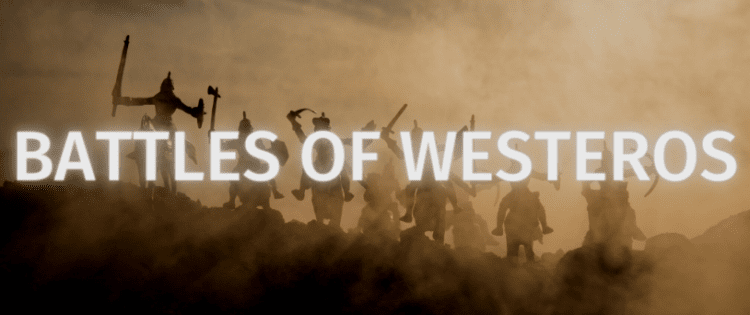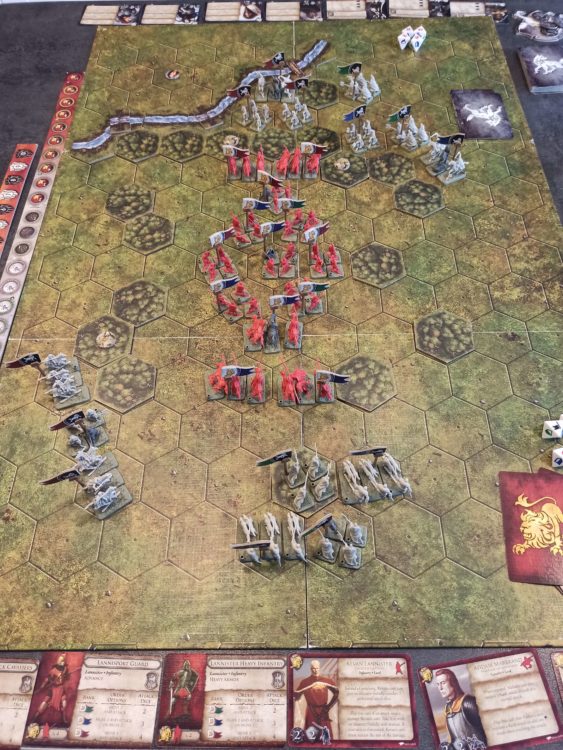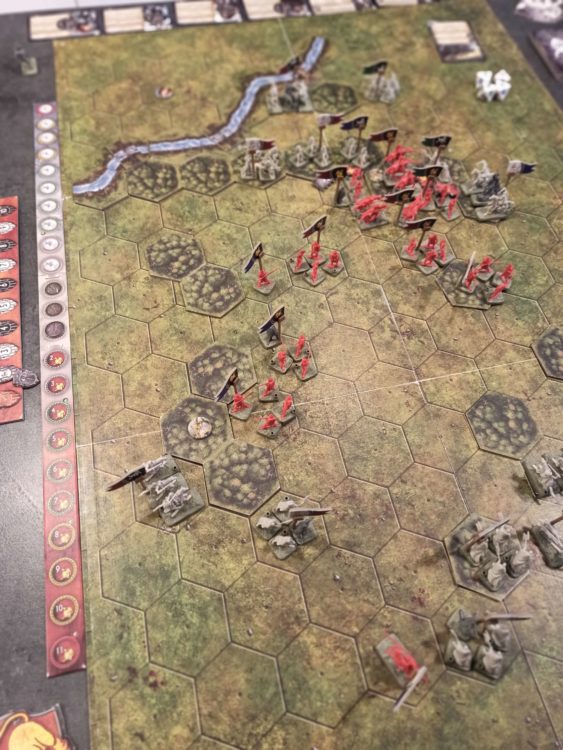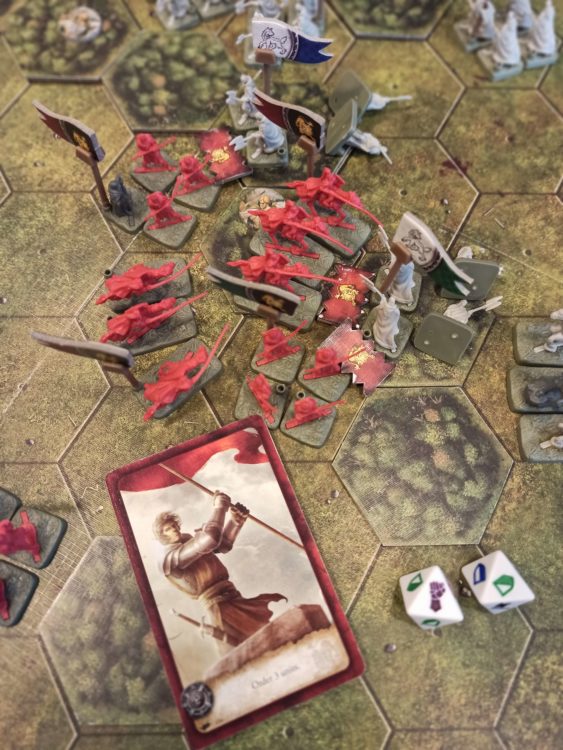
OBJECTIVE OF BATTLES OF WESTEROS: Rout the enemy or destroy him!
NUMBER OF PLAYERS: 2 players
MATERIALS:
- 138 figures (10 Commanders and 128 Soldiers split between Houses Stark and Lannister)
- 36 Banner Poles and 86 Unit Banners (43 of each House)
- 84 Order cards (14 Commander cards and 70 Leadership cards)
- 8 Unit Reference cards (4 of each House)
- 2 Command Boards (1 per House)
- 10 Command tokens
- 50 Order tokens (10 of each type: Green, Blue, Red, Valor, Morale)
- 20 Engagement tokens (10 per house)
- 8 eight-sided Combat Dice
- 14 control markers (7 per House)
- 32 Map tiles
- 16 Skirmish Setup cards and 2 Skirmish Summary cards
- 1 Momentum token
- 1 Morale track
- 1 Round track with a Round marker and 2 Victory Point markers (1 per House)
- 1 Game board (double-sided)
- Various status and game element tokens (Devastation, Fire, Strategy, Siege Tower, Tent…)
TYPE OF GAME: Battle Lore variant, battle game
AUDIENCE: Teens, Adults
INTRODUCTION OF BATTLES OF WESTEROS
The banners of the Great Houses of Westeros flutter in the wind. To rule the realm of the Seven Kingdoms and to ensure the survival of their bloodlines, the Houses of Westeros each have their own strategy.
Some forge matrimonial alliances, some create complex political intrigues, and others use dishonesty and treachery. But there is no more direct and lasting way than victory on the battlefield.
In Battles of Westeros, two players can take part in the military conflicts in George R. R. Martin’s Game of Thrones universe. Players can recreate battles from the books that opposed Stark and Lannister Houses or invent their own skirmishes.
From the map layout to the army compositions, and of course famous commanders that give access to different special orders and abilities, each of the 10 scenarii proposed by the game will provide a completely different battle experience.
This article does not entirely cover the rules of Battles of Westeros as it would be too long. Instead, it will give a detailed overview of how the game works to help grasp the game experience.
Contents of the core game box. Note that the plastic box for tokens is not sold with the game.
GAME SETUP
1. Battle and Houses
Each player chooses one House, either Stark or Lannister, then the player determine which battle they want to play in the Westeros Battle Plans book. The Battle Plan of a battle details the involved troops, commanders and victory conditions for each House.
2. Battlefield and Game Tracks
According to the Battle Plan, place terrain tiles on the correct side of the game board (side A or side B). Then, place the Morale track and Round track next to the battlefield, with their markers. The Morale track is made of three parts, the central part being neutral while the two ends are House specific and are two-sided. The Battle Plan indicates which side should be used, with either Rout or 11 Morale on their last space.
3. Commanders
Each player picks the Commander figures as specified in the Battle Plans, and then takes the Commander card of each Commander, places colored face up in front of them. They also take the 5 Leadership cards of each involved Commander.
4. Tokens
Each player takes the number of Command tokens specified on the Battle Plan and places them on his Command board.
All other tokens are sorted by type and placed next to the game board.
5. Leadership Decks
Each player shuffles the 10 base Leadership cards of his House with the Leadership cards of the involved Commanders.
6. Deployment
According to the Battle Plan, form each unit with figures, banner poles and banner tokens and place it on the right space of the board game. Commanders come with their unit, whose type is indicated on their Commander card, but they replace one of the figures.
7. Initiative
The Battle Plan states which player takes the Momentum token.

THE PLAY
A battle lasts a set maximum number of rounds, as indicated on the Battle Plan. A round is divided in four phases as follows:
- Rally Phase: determine advantage and rally your troops
- Marshaling Phase: roll combat dice and draw Leadership cards
- Command Phase: give orders to units
- Regroup Phase: resolve status conditions, score Victory Points and check victory conditions
Rally Phase
A. Determine Advantage
The first player is the one who has kept the most Commands tokens on his Command board. In case of a tie, the player with the momentum goes first.
B. Refresh Commanders
Each player moves all command tokens on his Commander cards back to his Command board.
C. Rally Units
Each unit has a banner with a black side and a white side. When a unit is ordered, its owner turns its banner at 180 degrees to show its other side and indicate the unit has been ordered and has become inactive. The Round track’s spaces have alternate colors, either black or white. This is used to facilitate the tracking of units being ordered. During this step of the Rally phase, each players turns the banner of units that are still active, so that all banners show him the color side matching the current round’s color on the game track. Therefore, if you have ordered all your units during the previous round, you don’t have anything to do. Well thought out.
Marshaling Phase
A. Roll Combat Dice to Determine the Colors of Order Tokens
Each player rolls the number of combat dice indicated on the Battle Plan and takes Order tokens as shown on the dice results. These Order tokens are added to the player’s Order pool.
B. Draw Scenario-Specific Number of Leadership Cards
Each player draws the number of Leadership cards indicated on the Battle Plan and adds them to their hand.
Command Phase
This is the most important phase of the game, during which the players give one order to their units, one player after the other, until players have used all their order possibilities or decided to pass.
To give an order, a player may choose one of 2 Options.
A. Play a single or a matching pair of Order Tokens
The active player may spend an Order token on a unit to do the following actions:
- green shield: order the unit (only if the unit is green)
- blue shield: order the unit (only if the unit is blue)
- red shield: order the unit (only if the unit is red)
- flag: either rally the unit (turn its banner to the side matching the current round’s color, but decrease your House’s morale by one) or increase your House’s morale by one
- fist (Valor): order the unit regardless of its color
B. Play a single Leadership Card
To play a Leadership card, the active player must follow the following steps and conditions:
- choose a commander (either active or inactive) that doesn’t have reached his limit of Command tokens (as specified on his Commander card)
- discard the Leadership card to play
- move a Command token from his Command board to the Commander’s card
- designate the units being ordered according to the Leadership card’s description; those units must be within a range of to hexes of the Commander
- apply the effect of the Leadership card’s description
Note: some Leadership cards may have several Orders, that require to spend as many Command tokens, or may have a Tactics text box, allowing to activate another nice effect if the conditions specified on the card are met.
C. Pass
The active player may pass if he wants to keep one Order token and/or one Leadership card for the next turn, but also to keep Command tokens in order to win initiative in the next turn. Also, a player must pass if he is not able to use any Order token or Leadeship card (in most cases, if he has used all his Command tokens and Order tokens).
Regroup Phase
A. Resolve Status Conditions
There are a lot of effects being triggered by game events depending on the scenarii played. One of them is the Fire condition, that can apply to buildings, but also to units.
B. Score Victory Points
Victory Points are earned differently in each scenario, according to the Battle Plan. Some Victory Points are earned each turn while others may only be awarded during the last round of the game. Most of the time, Victory Points are earned by eliminating enemy units and by having the enemy morale low on the Morale track.
C. Check Victory Conditions
Again, the Battle Plan specifies Victory conditions, either for Instant Victory or for Victory in the last round.
D. Discard Excess Resources
Players must discard all remaining Order tokens but one from their Order pool, and do the same for Leadership cards remaining in their hand.
E. Recover Morale
Each player may move his morale marker up to the highest morale space of the same color (green, yellow or red) unless his morale marker is on a morale break space (pointed by an arrow).
F. Advance Round Marker
The round marker is moved to the next space on the Round track.

More details on the rules
Unit Color (Rank)
A unit has a rank determined by the color of its banner:
- green: rookie unit, moves faster, rolls only two attack dice, is hit on green shield on a combat die
- blue: standard unit, moves normally, rolls three attack dice, is hit on blue shield on a combat die
- red: veteran unit, moves slowly, rolls four attack dice, is hit on red shield on a combat die
The combat dice heve three green shield faces, two blue shields face, one red shield face, one Valor (fist) face and one Morale (flag) face. Therefore, green units are the easiest to hit while red units are the hardest.
Moving Units
When ordered, a unit may move according to his rank as specified on its unit card. For example:
- a green cavalry unit may always move 4 and attack
- a blue cavalry unit may choose between moving 4 or moving 3 and attack
- a red cavalry unit may only move 3 and attack (but never move 4)
Attacking
When ordered, a unit may attack if it is adjacent to an enemy unit, regarless of any movement made by the unit, as long as it followed the move and attack limitations specified on its unit card. To attack,
- declare the attacker unit
- declare the target unit
- verify range and line of sight: for ranged attacks, the attacker unit must have a line of sight of half an hex space towards the target; units on Hill hexes aren’t blocked by other units between them and their target.
- place an engagement token (only for melee attacks) of the atatcker’s House on the edge between the two units
- take attack dice according to the unit’s rank and unit card, applying any modifier caused by terrain or other game elements
- roll attack dice:
- each result of the target unit’s color is a hit;
- each Valor result is also a hit, unless the attack was ranged, and unless the attacker unit is infantry and the target unit was cavalry
- each Morale result forces the target unit to move one hex towards its edge of the game board (as specified on the Battle Plan); any Morale result that could not be so applied because of blocking terrain or units causes another hit
Engagement Tokens, Parting Blows, Flanking
When attacking a unit that is already engaged, the attacker unit may reroll once any number of attack dice of one and only one color.
When a unit is engaged, it may only attack the unit it is engaged with, unless it chooses to disengage:
- when disengaging, a unit may suffer a parting blow from the unit it was engaged with; if that unit’s owner decides to deal the parting blow, it rolls its normal number of attack dice (morale results are ignored)
- if the unit wasn’t destroyed by the parting blow, the engagement token is removed and the disengaged unit may continue to apply its order, either to move or to directly attack another adjacent unit
Counterattacking
When attacked, a unit may counterattack if it has the Stalwart keyword. Some units have the keyword by default, but more interestingly, all units automatically acquire the keyword if they have at least two friendly adjacent units. When counterattacking, the unit’s owner rolls its normal number of attack dice.
Capturing Commander Units
When a Commander unit suffers hits, standard figures are removed first. When only the Commander figure remains in the unit, the Commander may be captured by dealing a number of hits equal to the Capture Rating indicated on the Commander’s card in a single attack.
Morale track
The morale track indicates how the battle is shifting towards one or the other side. The morale marker is pushed toward your opponent when your morale increases, by the following rules:
- +1 per green unit eliminated
- +2 per blue unit eliminated
- +3 per red unit eliminated
- +1 per Morale order token spent to increase morale
- -1 per Morale order token spent to rally a unit
In some scenarii, the Morale track’s last space on each side is a Rout space. If the Morale marker reaches that space, the army on that side immediately loses the battle.

Keywords Abilities
Advance: when eliminating a unit or forcing it to retreat, the unit may freely advance in the hex formerly occupied by the target unit.
Cover X / Toughness X: the unit ignores the X first hits when being attacked.
Dogs of War: Stark Kennelmaster units may send their dogs to attack a unit within 2 or 3 hexes. This special attack is resolved by rolling one die and applying the following effects:
- green shield: roll attack dice as if the unit was a green unit
- blue shield: roll attack dice as if the unit was a blue unit
- red shield: roll attack dice as if the unit was a red unit
- morale: the target unit must retreat one hex
- valor: the target unit suffers one hit
Friendly never block line of sight for Dogs of War attacks.
Heavy Armor: the unit is considered one rank higher when being attacked. If the unit is red, it instead ignores hits caused by Valor results.
Off-balance: the unit may move and attack, but loses one attack die if it has moved before attacking.
Pursue X: when attacking, if the target unit was destroyed or forced to retrat, the unit may decide to move on up to X hexes, starting with the hex occupied by its first target. If it does so and ends its movement being adjacent to any enemy unit, it may attack again. This ability can be used only once per round by the unit.
Scorch the Earth: the unit may set to fire an unoccupied adjacent hex instead of attacking.
Satlwart: the unit ignores the first morale result when attacked, and can counterattack. Any unit being adjacent to two or more friendly units automatically gains the Stalwart keyword.
WINNING
As specified in the Regroup phase description, the game ends when one of the players meets the Victory conditions detailed on the Battle Plan.
VARIANTS
The core games offers ten very different battles as long as a skirmish mode, allowing to create random, slightly shorter encounters.
Battles of Westeros has several expansions that add new units and Battle Plans for Stark and Lannister Houses, and also House Baratheon units.
- Comprehensive Guide to the Board Game Go (weiqi, baduk) - January 23, 2024
- Are Creative Suites Changing Gaming - October 30, 2023
- How Classic Games Have Been Reimagined for Modern Audiences - October 5, 2023